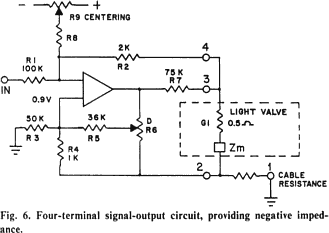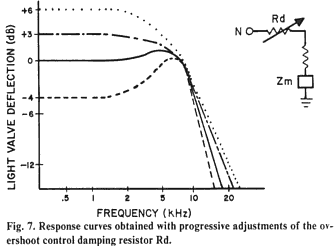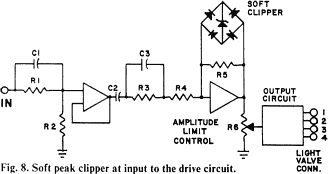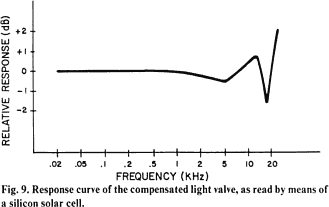 |  |
The CCD pickup assembly is similar to a small video camera, using a long object-to-lens working distance and a short-focal-length objective lens. Our first unit has the lens on one mount, while the CCD, drive electronics and video output amplifier are contained on a circuit card, which is mounted separately as a self-functioning unit. On production units, both of the above sub-assemblies will form one module, which will be mounted and focused by the lens tube. The lens tube will be mounted in accordance with current practice, and the electronics will be housed in the existing exciter-lamp compartment. Conversely, the exciter lamp, second-stage condenser and IR shield form an assembly, to be mounted within the sound drum on the existing solar cell bracket. Both of these units can operate with long cables and can therefore be treated like their conventional counterparts within the sound head.
Boundary Scan Reading.
This technique affords a simple method of reading a multiplicity of recorded tracks, with very high stability and minimal crosstalk. Presently only four tracks are used. Readback is by transversal scanning of the moving image edges of a modulated track, recognizing and converting the edge transition point, to the rise or fall components of a variable-area constant-amplitude electrical pulse. The average duration of the pulse in time then is proportional to the average illuminated width of the image slit. Many signal tracks or moving edges become width-modulated pulse trains (Fig. 12) the position of which within the scan window can be recognized by the CCD. For the Colortek system, each pulse train is derived from a modulated track edge, or recorded reference edge. These pulse edges, when compared to an internal time reference, give variable-area samples, which are each commuted to individual charge-holding circuits or channel receptors. This arrangement then gives a serial edge-to-parallel-track conversion. The channel commutations are filtered to yield individual signals, the amplitude of which is proportional to the modulation area of each individual track. Since these events are each isolated in time, the system channel-to-channel crosstalk is very low. More important, if the time-reference circuits follow the average track positions, or a recorded reference edge, the readback is insensitive to where the pulse train begins or ends, within the scan window. Hence the film position and weave errors only move the pulse train, as a group, with respect to the scan window. The timing and information segments of the train remain unchanged, as does the commuted signal and its channel-to-channel crosstalk.Electronic Slicing.
The edge boundary of the modulated track as projected and focused on the CCD varies from a minimum luminous transmittance on one side to a maximum transmittance on the other side (Fig. 13a). Between these points, the edge is defined by a curve, the shape of which depends upon the nature of the film emulsion, its exposure, processing and the nature of the recorded edge object image and its focus. Microscopic examination has shown that the transition from a 10% to 90% of the minimum to maximum transmittance usually occurs in less than 4 µm for commercial prints and less than 1 µm for optimum experimental negatives. The slope, or sharpness, appears to be independent of small transmittance changes that can occur within the accepted tolerances of normal production printing. Any desired transmittance value, falling along the 10% to 90% curve, can be converted to the beginning or end of a pulse. This value, termed the "slicing point," produces an equivalent recorded image size, since the electrical pulse width changes with the setting. Adjustment of the slicing point alters the electrical readback image size by as much as 4 µm. Cross-modulation distortion, audibly recognizable as sibilant blocking, is at its lowest when the slicing point sets the scaled pulse width equal to the correct object image size, determined by optimum negative exposure, in accordance with standard cross-modulation testing procedures. Optimal selection of
 |  |